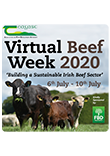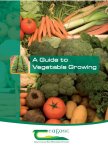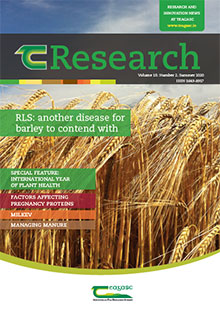
Soil organic matter is the biggest store of carbon on land. It is greater than the carbon in the atmosphere in the form of carbon dioxide (CO2) gas which is a greenhouse gas. Researchers David Wall & Gary Lanigan have information on why maintaining soil organic matter levels is important?
- Date
- 08 July 2020
- Type
- Media Article

Cattle slurry is a valuable source of N, P & K produced on farm. The nitrogen (N) in cattle slurry is in the ammonia form similar to N in urea fertilisers and as such can be easily lost to the atmosphere. Slurry application techniques such as trailing hose or trailing shoe reduce the surface area of the slurry compared to the splash plate thus reducing the loss of N as ammonia to the air.
- Date
- 08 July 2020
- Type
- Media Article

The ASSAP is a new government / industry collaborative initiative running from 2018 - 2021. The programme offers a free support and advisory service (20 Teagasc and 10 Dairy Co-op advisors) and participation is voluntary. Its aim is to improve water quality through working with farmers
- Date
- 08 July 2020
- Type
- Media Article

White Clover will increase grass production and quality. It improves animal performance - 13% increase in animal carcass weight & 25% increase in lamb live weight gain. It saves €50/acre on Nitrogen fertiliser (save 110 units N/acre, CAN @ €250/t ) and gives a 20% reduction in greenhouse gas emissions
- Date
- 08 July 2020
- Type
- Media Article

A better environment and supporting the production of high-quality food are the twin aims of the ACP. Funded by the Department of Agriculture, Food and the Marine, staff have been working with 300 farmers across six catchments in Ireland for over ten years to achieve these goals while also evaluating the Nitrates Directive regulations.
- Date
- 08 July 2020
- Type
- Media Article

Methane (CH4) is the second most important greenhouse gas (GHG) in terms of global warming. It is 28 times more potent to the environment than carbon dioxide (CO2). Agriculture accounts for 34% of Irish GHGs emissions, with CH4 responsible for nearly 60% of agri emissions.
- Date
- 08 July 2020
- Type
- Media Article

Protected urea (ProUrea) is urea which is treated with a urease inhibitor. The urease inhibitor can be either a) coated onto the outside of the fertiliser granule or b) incorporated into the urea granule melt during manufacture.
- Date
- 08 July 2020
- Type
- Media Article

The 9th edition of A Guide to Vegetable growing.
- Date
- 07 July 2020
- Type
- Book

The Dairy Beef Index (DBI) is a tool to produce quality beef cattle from the dairy herd that have both desirable calving attributes for the dairy herd (i.e. easy calving and short gestation) and valuable carcass merit attributes for the finisher.
- Date
- 07 July 2020
- Type
- Media Article

RLS: another disease for barley to contend with
- Date
- 07 July 2020
- Type
- Magazine
